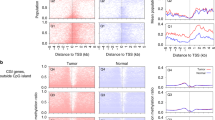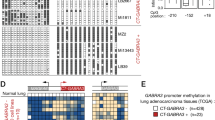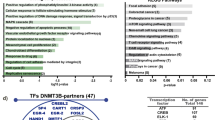Abstract
Epigenetic silencing in cancer cells is mediated by at least two distinct histone modifications, polycomb-based histone H3 lysine 27 trimethylation (H3K27triM) and H3K9 dimethylation. The relationship between DNA hypermethylation and these histone modifications is not completely understood. Using chromatin immunoprecipitation microarrays (ChIP-chip) in prostate cancer cells compared to normal prostate, we found that up to 5% of promoters (16% CpG islands and 84% non-CpG islands) were enriched with H3K27triM. These genes were silenced specifically in prostate cancer, and those CpG islands affected showed low levels of DNA methylation. Downregulation of the EZH2 histone methyltransferase restored expression of the H3K27triM target genes alone or in synergy with histone deacetylase inhibition, without affecting promoter DNA methylation, and with no effect on the expression of genes silenced by DNA hypermethylation. These data establish EZH2-mediated H3K27triM as a mechanism of tumor-suppressor gene silencing in cancer that is potentially independent of promoter DNA methylation.
This is a preview of subscription content, access via your institution
Access options
Subscribe to this journal
Receive 12 print issues and online access
$209.00 per year
only $17.42 per issue
Buy this article
- Purchase on Springer Link
- Instant access to full article PDF
Prices may be subject to local taxes which are calculated during checkout







Similar content being viewed by others
Accession codes
References
Jenuwein, T. & Allis, C.D. Translating the histone code. Science 293, 1074–1080 (2001).
Herman, J.G. & Baylin, S.B. Gene silencing in cancer in association with promoter hypermethylation. N. Engl. J. Med. 349, 2042–2054 (2003).
Cao, R. & Zhang, Y. The functions of E(Z)/EZH2-mediated methylation of lysine 27 in histone H3. Curr. Opin. Genet. Dev. 14, 155–164 (2004).
Lachner, M. & Jenuwein, T. The many faces of histone lysine methylation. Curr. Opin. Cell Biol. 14, 286–298 (2002).
Levine, S.S. et al. The core of the polycomb repressive complex is compositionally and functionally conserved in flies and humans. Mol. Cell. Biol. 22, 6070–6078 (2002).
Dellino, G.I. et al. Polycomb silencing blocks transcription initiation. Mol. Cell 13, 887–893 (2004).
Shao, Z. et al. Stabilization of chromatin structure by PRC1, a Polycomb complex. Cell 98, 37–46 (1999).
Varambally, S. et al. The polycomb group protein EZH2 is involved in progression of prostate cancer. Nature 419, 624–629 (2002).
Kleer, C.G. et al. EZH2 is a marker of aggressive breast cancer and promotes neoplastic transformation of breast epithelial cells. Proc. Natl. Acad. Sci. USA 100, 11606–11611 (2003).
Leung, C. et al. Bmi1 is essential for cerebellar development and is overexpressed in human medulloblastomas. Nature 428, 337–341 (2004).
Kondo, Y., Shen, L., Yan, P.S., Huang, T.H. & Issa, J.P. Chromatin immunoprecipitation microarrays for identification of genes silenced by histone H3 lysine 9 methylation. Proc. Natl. Acad. Sci. USA 101, 7398–7403 (2004).
Toyota, M. et al. CpG island methylator phenotype in colorectal cancer. Proc. Natl. Acad. Sci. USA 96, 8681–8686 (1999).
Toyota, M. et al. Identification of differentially methylated sequences in colorectal cancer by methylated CpG island amplification. Cancer Res. 59, 2307–2312 (1999).
Cross, S.H., Charlton, J.A., Nan, X. & Bird, A.P. Purification of CpG islands using a methylated DNA binding column. Nat. Genet. 6, 236–244 (1994).
Kirmizis, A. et al. Silencing of human polycomb target genes is associated with methylation of histone H3 Lys 27. Genes Dev. 18, 1592–1605 (2004).
Bracken, A.P. et al. EZH2 is downstream of the pRB-E2F pathway, essential for proliferation and amplified in cancer. EMBO J. 22, 5323–5335 (2003).
Bernstein, B.E. et al. A bivalent chromatin structure marks key developmental genes in embryonic stem cells. Cell 125, 315–326 (2006).
Brennan, K.R. & Brown, A.M. Wnt proteins in mammary development and cancer. J. Mammary Gland Biol. Neoplasia 9, 119–131 (2004).
Asatiani, E. et al. Deletion, methylation, and expression of the NKX3.1 suppressor gene in primary human prostate cancer. Cancer Res. 65, 1164–1173 (2005).
Boyer, L.A. et al. Core transcriptional regulatory circuitry in human embryonic stem cells. Cell 122, 947–956 (2005).
Schlesinger, Y. et al. Polycomb-mediated methylation on Lys27 of histone H3 pre-marks genes for de novo methylation in cancer. Nat. Genet. 39, 232–236 (2007).
Widschwendter, M. et al. Epigenetic stem cell signature in cancer. Nat. Genet. 39, 157–158 (2007).
Ohm, J.E. et al. A stem cell-like chromatin pattern may predispose tumor suppressor genes to DNA hypermethylation and heritable silencing. Nat. Genet. 39, 237–242 (2007).
Vire, E. et al. The Polycomb group protein EZH2 directly controls DNA methylation. Nature 439, 871–874 (2006).
Estecio, M.R. et al. High-throughput methylation profiling by MCA coupled to CpG island microarray. Genome Res. 17, 1529–1536 (2007).
Shen, L. et al. Genome-wide profiling of DNA methylation reveals a class of normally methylated CpG island promoters. PLoS Genet. 3, 2023–2036 (2007).
Dey, A., Minucci, S. & Ozato, K. Ligand-dependent occupancy of the retinoic acid receptor beta 2 promoter in vivo. Mol. Cell. Biol. 14, 8191–8201 (1994).
Benetti, R. et al. The death substrate Gas2 binds m-calpain and increases susceptibility to p53-dependent apoptosis. EMBO J. 20, 2702–2714 (2001).
Issa, J.P. CpG island methylator phenotype in cancer. Nat. Rev. Cancer 4, 988–993 (2004).
Plath, K. et al. Role of histone H3 lysine 27 methylation in X inactivation. Science 300, 131–135 (2003).
Kondo, Y. & Issa, J.-P. Enrichment for histone H3 lysine 9 methylation at Alu repeats in human cells. J. Biol. Chem. 278, 27658–27662 (2003).
Martens, J.H. et al. The profile of repeat-associated histone lysine methylation states in the mouse epigenome. EMBO J. 24, 800–812 (2005).
Weinmann, A.S., Yan, P.S., Oberley, M.J., Huang, T.H. & Farnham, P.J. Isolating human transcription factor targets by coupling chromatin immunoprecipitation and CpG island microarray analysis. Genes Dev. 16, 235–244 (2002).
Pokholok, D.K. et al. Genome-wide map of nucleosome acetylation and methylation in yeast. Cell 122, 517–527 (2005).
Clark, S.J., Harrison, J., Paul, C.L. & Frommer, M. High sensitivity mapping of methylated cytosines. Nucleic Acids Res. 22, 2990–2997 (1994).
Colella, S., Shen, L., Baggerly, K.A., Issa, J.-P. & Krahe, R. Sensitive and quantitative universal Pyrosequencing methylation analysis of CpG sites. Biotechniques 35, 146–150 (2003).
Campisi, J. Analysis of tumor suppressor gene-induced senescence. Methods Mol. Biol. 223, 155–172 (2003).
Acknowledgements
This work was supported in part by US National Institutes of Health by grants P50CA100632, R33CA89837 and RO1CA098006 to J.-P.J.I. and grant P50CA058204 to B.K.-A. J.-P.J.I. is an American Cancer Society Clinical Research Professor supported by a generous gift from the F.M. Kirby Foundation. Y.K. was supported by an Odyssey Fellowship at the M.D. Anderson Cancer Center and the Cell Science Research Foundation. We especially thank Y. Guo and X. Chen for their technical assistance.
Author information
Authors and Affiliations
Contributions
Y.K. and J.-P.J.I. designed the research; Y.K., L.S., A.S.C., S.A., Y.B. and C.C. performed the research; T.Y., T.U., K.F., Y.S. and T.H.-M.H. designed the assays; D.L.G. analyzed microarray data; B.K.-A. collected and analyzed clinical samples; and Y.K. and J.-P.J.I. wrote the paper.
Corresponding author
Supplementary information
Supplementary Text and Figures
Supplementary Figures 1–3 and Supplementary Tables 1–5 (PDF 4384 kb)
Rights and permissions
About this article
Cite this article
Kondo, Y., Shen, L., Cheng, A. et al. Gene silencing in cancer by histone H3 lysine 27 trimethylation independent of promoter DNA methylation. Nat Genet 40, 741–750 (2008). https://doi.org/10.1038/ng.159
Received:
Accepted:
Published:
Issue Date:
DOI: https://doi.org/10.1038/ng.159
This article is cited by
-
Loss of H3K27 methylation identifies poor outcomes in adult-onset acute leukemia
Clinical Epigenetics (2021)
-
Epigenetic regulation of TGF-β-induced EMT by JMJD3/KDM6B histone H3K27 demethylase
Oncogenesis (2021)
-
DNMT and HDAC inhibitors modulate MMP-9-dependent H3 N-terminal tail proteolysis and osteoclastogenesis
Epigenetics & Chromatin (2019)
-
RETRACTED ARTICLE: Molecular mechanisms in progression of HPV-associated cervical carcinogenesis
Journal of Biomedical Science (2019)
-
Distinct DNA methylation targets by aging and chronic inflammation: a pilot study using gastric mucosa infected with Helicobacter pylori
Clinical Epigenetics (2019)



